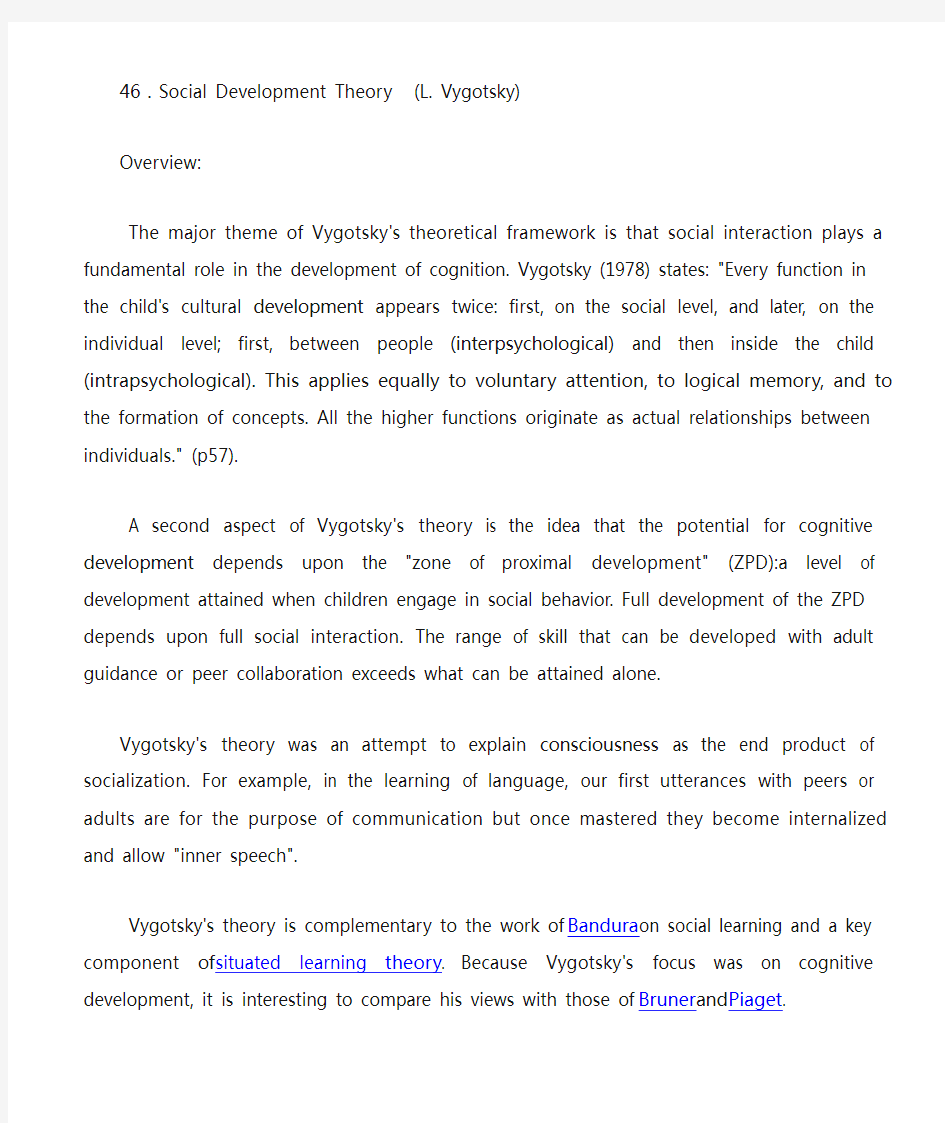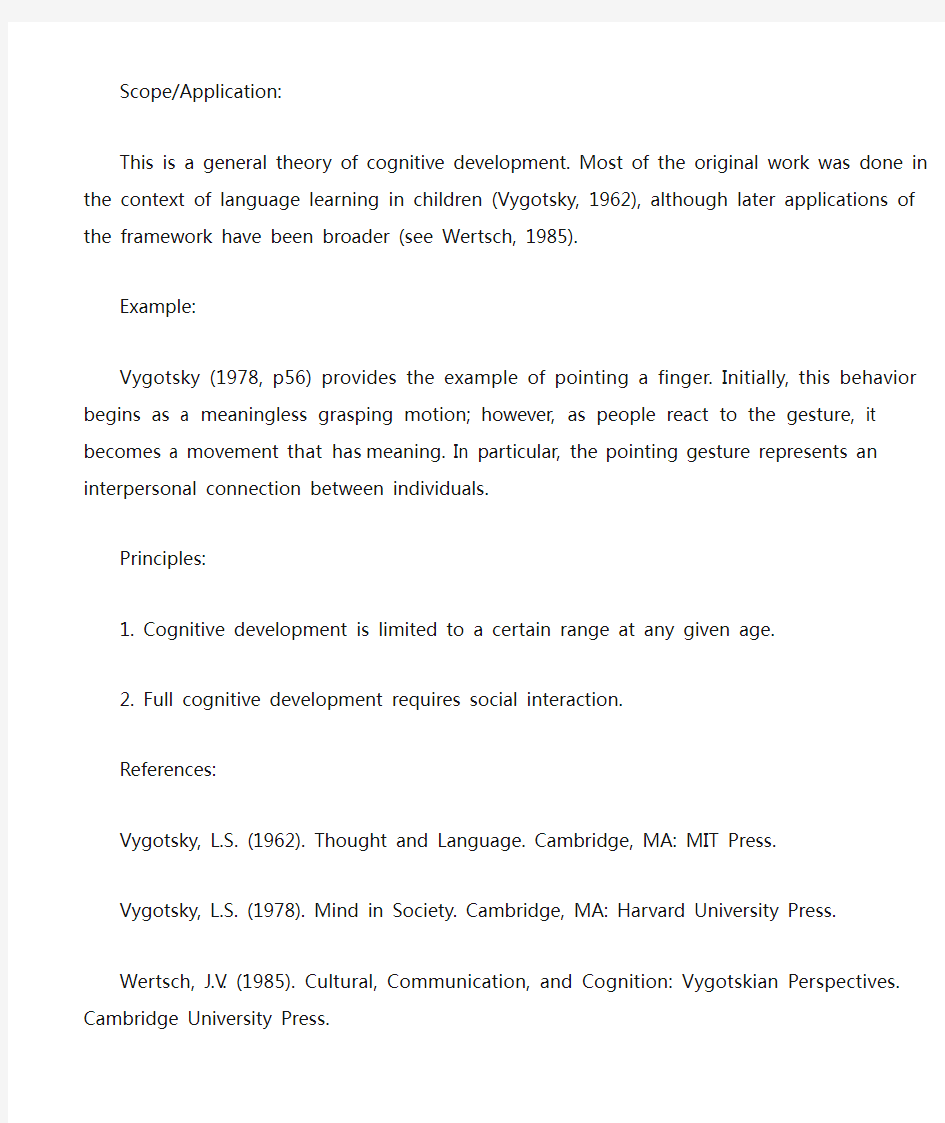社会发展理论


46.Social Development Theory (L. Vygotsky)
Overview:
The major theme of Vygotsky's theoretical framework is that social interaction plays a fundamental role in the development of cognition. Vygotsky (1978) states: "Every function in the child's cultural development appears twice: first, on the social level, and later, on the individual level; first, between people (interpsychological) and then inside the child (intrapsychological). This applies equally to voluntary attention, to logical memory, and to the formation of concepts. All the higher functions originate as actual relationships between individuals." (p57).
A second aspect of Vygotsky's theory is the idea that the potential for cognitive development depends upon the "zone of proximal development" (ZPD):a level of development attained when children engage in social behavior. Full development of the ZPD depends upon full social interaction. The range of skill that can be developed with adult guidance or peer collaboration exceeds what can be attained alone.
Vygotsky's theory was an attempt to explain consciousness as the end product of socialization. For example, in the learning of language, our first utterances with peers or adults are for the purpose of communication but once mastered they become internalized and allow "inner speech".
Vygotsky's theory is complementary to the work of Bandura on social learning and a key component of situated learning theory. Because Vygotsky's focus was on cognitive development, it is interesting to compare his views with those of Bruner and Piaget.
Scope/Application:
This is a general theory of cognitive development. Most of the original work was done in the context of language learning in children (Vygotsky, 1962), although later applications of the framework have been broader (see Wertsch, 1985). Example:
Vygotsky (1978, p56) provides the example of pointing a finger. Initially, this behavior begins as a meaningless grasping motion; however, as people react to the gesture, it becomes a movement that has meaning. In particular, the pointing gesture represents an interpersonal connection between individuals.
Principles:
1. Cognitive development is limited to a certain range at any given age.
2. Full cognitive development requires social interaction.
References:
Vygotsky, L.S. (1962). Thought and Language. Cambridge, MA: MIT Press. Vygotsky, L.S. (1978). Mind in Society. Cambridge, MA: Harvard University Press. Wertsch, J.V. (1985). Cultural, Communication, and Cognition: Vygotskian Perspectives. Cambridge University Press.
社会发展理论(L.维果茨基)
概述:
维果茨基的理论框架的重要主题之一就是社会互动在认知发展中起着至关重要的作用。维果茨基(1978)陈述:“在孩子的文化发展中其每一个功能都会出现两次:起初在社会层面上,之后在个人层面上;首先,在人和孩子的内心世界之间。这同样适用于随意注意,逻辑记忆以及概念的形成。所有较高级的功能最初作为个人之间的实际关系。“(P57)。
维果茨基的理论的第二个方面是认知能力的发展潜力取决于“最近发展区”(ZPD):一种当儿童从事社会行为时所获得的发展水平。全面发展的ZPD取决于全面的社会互动。这种在与成人的指导或对等合作中的开发出来的能力范围超过了个体单独活动所发展的技能。
维果茨基的理论试图解释作为社会化最终产品的社会意识。例如,在语言的学习中,我们与同龄人或成年人交往的第一个目的即沟通交流,但一旦掌握了这门语言,他们将被内化,并允许“内部讲话”。
维果茨基的理论是班杜拉的社会学习理论的补充以及情境学习理论的重要组成部分。由于维果茨基的重点放在认知能力的发展,将他的观点与布鲁纳和皮亚杰的观点放在一起进行比较是很有趣的。
应用范围:
这是一个普遍的认知发展理论。大多数原始工作在孩子进行语言学习的的背景下已经完成(维果茨基,1962年),尽管理论框架后来的功能已经被广泛地扩展(见Wertsch,1985)。
示例:
维果茨基(1978年,第56页)提供了一个指手指的例子。最初,这种行为
开始作为一个毫无意义的抓动作,但是,随着人们对这种姿态作出反应,它就变成了一种有着特殊意义的运动。实际上,指示手势代表一种个体之间的人际交往互动。
原则:
1、认知发展在任何给定的年龄阶段都被限制在一定范围内。
2、完全认知能力的发展需要社会的互动。
参考文献:
维果茨基,L.S. (1962)思维与语言剑桥,MA:MIT出版社。
维果茨基,L.S. (1978)社会中的心灵剑桥,MA:哈佛大学出版社出版。wertsch,J.V.(1985)文化,交流和认知:维果茨基的观点剑桥大学出版社。
